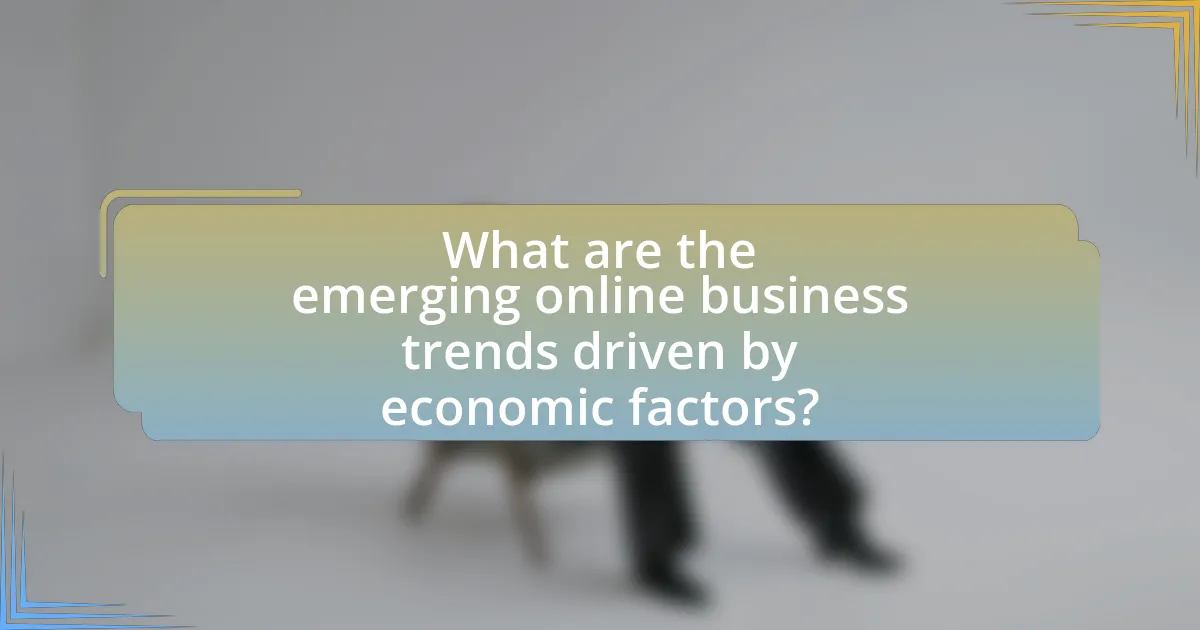The article examines the impact of key economic factors on online business trends, focusing on elements such as consumer spending, technological advancements, market competition, and economic stability. It highlights how consumer behavior, influenced by disposable income and economic conditions, shapes online purchasing patterns and business strategies. Additionally, the article discusses the implications of inflation, interest rates, and globalization on pricing strategies, supply chain management, and market competition. It also explores emerging trends in e-commerce, mobile commerce, and subscription-based services, emphasizing the importance of leveraging economic data for strategic planning and adaptation in a fluctuating economic landscape.

What are the key economic factors influencing online business trends?
Key economic factors influencing online business trends include consumer spending, technological advancements, and market competition. Consumer spending directly affects online sales; for instance, in 2020, U.S. e-commerce sales grew by 32.4% compared to the previous year, driven by increased consumer demand during the pandemic. Technological advancements, such as improved internet infrastructure and mobile payment systems, facilitate online transactions and enhance user experience, contributing to the growth of online businesses. Additionally, market competition compels businesses to innovate and adapt, as seen in the rise of subscription models and personalized marketing strategies, which are responses to competitive pressures in the digital marketplace.
How do consumer spending habits affect online business trends?
Consumer spending habits significantly influence online business trends by dictating demand for products and services. When consumers prioritize spending on essentials, online retailers often see increased sales in categories like groceries and household items, as evidenced by a 2020 report from McKinsey, which highlighted a 30% increase in online grocery shopping during the pandemic. Conversely, when consumers shift their spending towards discretionary items, such as luxury goods or travel, online businesses adapt their marketing strategies and inventory to align with these preferences. This adaptability is crucial, as a 2021 Statista survey indicated that 54% of consumers are willing to switch brands based on price and availability, demonstrating the direct correlation between consumer spending habits and online business strategies.
What role does disposable income play in online purchasing behavior?
Disposable income significantly influences online purchasing behavior, as it determines the amount of money consumers have available for discretionary spending after essential expenses. Higher disposable income typically leads to increased online purchases, as consumers feel more financially secure and willing to spend on non-essential goods and services. For instance, a study by the Bureau of Economic Analysis indicates that when disposable income rises, retail sales, including online shopping, tend to increase correspondingly, reflecting a direct correlation between income levels and consumer spending habits.
How do economic downturns impact consumer confidence in online shopping?
Economic downturns significantly decrease consumer confidence in online shopping. During such periods, consumers often face financial uncertainty, leading to reduced discretionary spending. For instance, a survey by the Conference Board in 2020 indicated that consumer confidence dropped sharply during economic recessions, with many individuals prioritizing essential purchases over non-essential online shopping. This shift in behavior results in lower sales for e-commerce businesses, as consumers become more cautious about their spending habits and may delay or forgo online purchases altogether.
What is the significance of inflation on online business operations?
Inflation significantly impacts online business operations by increasing costs and altering consumer purchasing behavior. As inflation rises, the cost of goods and services increases, leading to higher operational expenses for online businesses, including shipping, inventory, and marketing. For instance, a report from the Bureau of Labor Statistics indicated that the Consumer Price Index rose by 7% in 2021, which directly affected pricing strategies for e-commerce companies. Additionally, inflation can reduce consumers’ disposable income, leading to decreased spending on non-essential items, which online retailers must account for in their sales forecasts and inventory management.
How does inflation affect pricing strategies for online retailers?
Inflation significantly impacts pricing strategies for online retailers by forcing them to adjust prices to maintain profit margins. As the cost of goods and services rises, retailers often increase their prices to offset higher operational costs, including shipping, labor, and raw materials. For instance, a report from the Bureau of Labor Statistics indicated that consumer prices rose by 5.4% in 2021, prompting many retailers to reevaluate their pricing models. Additionally, online retailers may adopt dynamic pricing strategies, utilizing algorithms to adjust prices in real-time based on market conditions and competitor pricing, ensuring competitiveness while managing profit margins. This strategic adjustment is essential for sustaining business viability in an inflationary environment.
What are the implications of rising costs on supply chain management for online businesses?
Rising costs significantly impact supply chain management for online businesses by increasing operational expenses and necessitating strategic adjustments. As costs for raw materials, transportation, and labor rise, online businesses face tighter profit margins, compelling them to reassess pricing strategies and supplier relationships. For instance, a report from the Council of Supply Chain Management Professionals indicates that transportation costs have surged by over 20% in recent years, directly affecting logistics budgets. Consequently, online businesses may need to invest in technology for better inventory management and demand forecasting to mitigate these rising costs, ensuring they remain competitive while maintaining customer satisfaction.
How do interest rates influence online business growth?
Interest rates significantly influence online business growth by affecting consumer spending and borrowing costs. When interest rates are low, consumers are more likely to borrow money and spend on goods and services, which can lead to increased sales for online businesses. For instance, a Federal Reserve report indicated that lower interest rates can stimulate economic activity by making loans cheaper, thereby encouraging consumer purchases. Conversely, high interest rates can deter spending and increase the cost of financing for businesses, potentially slowing growth. Historical data shows that during periods of low interest rates, such as post-2008 financial crisis, many online businesses experienced rapid growth due to increased consumer confidence and spending power.
What impact do low interest rates have on e-commerce investments?
Low interest rates positively impact e-commerce investments by reducing the cost of borrowing, which encourages businesses to invest in technology, infrastructure, and marketing. When interest rates are low, companies can secure loans at lower costs, enabling them to expand their online operations and enhance customer experiences. For instance, according to the Federal Reserve, a decrease in interest rates can lead to increased consumer spending, which directly benefits e-commerce sales. Additionally, a report by McKinsey & Company indicates that lower borrowing costs can lead to a surge in digital transformation initiatives among retailers, further driving e-commerce growth.
How can high interest rates affect consumer financing options for online purchases?
High interest rates can significantly limit consumer financing options for online purchases by increasing the cost of borrowing. When interest rates rise, lenders typically charge higher rates on credit products, making loans and credit cards more expensive for consumers. This can lead to reduced consumer spending, as individuals may be less willing to finance purchases when the cost of credit is high. For instance, a study by the Federal Reserve indicates that higher interest rates can lead to a decrease in consumer credit demand, as borrowers become more cautious about taking on debt. Consequently, online retailers may experience a decline in sales as consumers opt to delay or forgo purchases due to the increased financial burden associated with high interest rates.

How do global economic trends shape online business strategies?
Global economic trends significantly influence online business strategies by dictating market demand, consumer behavior, and competitive dynamics. For instance, during economic downturns, businesses often pivot to cost-effective digital marketing strategies and enhance their online presence to reach a broader audience. According to a report by McKinsey, companies that invested in digital transformation during the 2008 financial crisis emerged stronger, highlighting the necessity of adapting to economic shifts. Additionally, fluctuations in currency exchange rates can affect pricing strategies for e-commerce businesses operating internationally, compelling them to adjust their pricing models to maintain competitiveness. Thus, understanding and responding to global economic trends is crucial for online businesses to thrive in a dynamic marketplace.
What are the effects of globalization on online market competition?
Globalization significantly intensifies online market competition by increasing the number of market participants and expanding consumer access to diverse products and services. This heightened competition arises as businesses from different countries can easily enter new markets through digital platforms, leading to a broader range of choices for consumers. For instance, a study by the World Trade Organization indicates that e-commerce has facilitated cross-border trade, with global online sales reaching approximately $4.28 trillion in 2020, reflecting a 27.6% increase from the previous year. Consequently, companies must adapt their strategies to compete not only locally but also on a global scale, often resulting in lower prices and improved quality for consumers.
How does access to international markets benefit online businesses?
Access to international markets significantly benefits online businesses by expanding their customer base and increasing sales opportunities. By reaching consumers in different countries, online businesses can tap into diverse markets, which can lead to higher revenue streams. For instance, a report by the International Trade Centre indicates that small and medium-sized enterprises (SMEs) that engage in international trade can see their sales increase by up to 20% compared to those that operate solely domestically. This access allows businesses to mitigate risks associated with local economic downturns and seasonal fluctuations, ensuring more stable income. Additionally, entering international markets can enhance brand visibility and credibility, as businesses are perceived as more competitive and innovative when they operate on a global scale.
What challenges do online businesses face in a globalized economy?
Online businesses face several challenges in a globalized economy, including intense competition, regulatory compliance, and cultural differences. Intense competition arises as businesses from various countries enter the same markets, making it difficult for individual companies to maintain market share. Regulatory compliance is another significant challenge, as online businesses must navigate different laws and regulations in each country, which can include data protection laws, tax regulations, and consumer rights. Cultural differences also pose challenges, as businesses must adapt their marketing strategies and product offerings to meet the diverse preferences and expectations of consumers across different regions. These challenges are critical for online businesses to address in order to succeed in a global marketplace.
How do economic policies influence online business regulations?
Economic policies significantly influence online business regulations by shaping the legal and operational framework within which these businesses operate. For instance, policies that promote free trade can lead to fewer restrictions on e-commerce, encouraging cross-border transactions and competition. Conversely, protectionist policies may impose tariffs or regulations that limit online business activities, affecting market access and operational costs. A concrete example is the European Union’s General Data Protection Regulation (GDPR), which was influenced by economic policies aimed at protecting consumer rights and data privacy, thereby impacting how online businesses handle user data. This regulatory framework illustrates how economic considerations directly translate into specific regulations that govern online business practices.
What role do trade agreements play in shaping online business opportunities?
Trade agreements significantly enhance online business opportunities by reducing tariffs and trade barriers, facilitating easier access to international markets. For instance, the United States-Mexico-Canada Agreement (USMCA) has streamlined digital trade regulations, allowing businesses to operate more efficiently across borders. According to the Office of the United States Trade Representative, the USMCA is expected to increase exports and create jobs in the digital economy, demonstrating the tangible benefits of such agreements. By fostering a more predictable trading environment, trade agreements encourage investment in e-commerce and digital services, ultimately expanding market reach for online businesses.
How can changes in taxation impact online business profitability?
Changes in taxation can significantly impact online business profitability by altering operational costs and consumer purchasing behavior. For instance, an increase in sales tax can lead to higher prices for consumers, potentially reducing demand for products and services offered by online businesses. According to a study by the National Bureau of Economic Research, a 1% increase in sales tax can decrease consumer spending by approximately 0.5%. Conversely, tax incentives or reductions can enhance profitability by lowering operational costs, allowing businesses to invest more in marketing and expansion. A report from the Tax Foundation indicates that businesses in lower tax environments tend to experience higher growth rates, further supporting the correlation between taxation and profitability.
What is the relationship between economic stability and online consumer behavior?
Economic stability significantly influences online consumer behavior by affecting purchasing power and confidence. When economic conditions are stable, consumers tend to spend more freely, leading to increased online shopping activity. For instance, during periods of economic growth, disposable income rises, resulting in higher online sales; in 2020, e-commerce sales in the U.S. grew by 32.4% compared to the previous year, largely due to economic recovery post-recession. Conversely, during economic downturns, consumers often prioritize essential purchases and reduce discretionary spending, which can lead to a decline in online sales. This relationship is supported by data from the Bureau of Economic Analysis, which shows that consumer spending patterns shift in response to changes in economic indicators such as GDP growth and unemployment rates.
How does economic uncertainty affect online shopping trends?
Economic uncertainty typically leads to a decline in online shopping trends as consumers become more cautious with their spending. During periods of economic instability, such as recessions or high inflation, individuals often prioritize essential purchases over discretionary spending, resulting in reduced online sales for non-essential goods. For instance, a study by the National Retail Federation indicated that during economic downturns, consumer confidence drops, which directly correlates with decreased online retail sales. Additionally, data from the U.S. Bureau of Economic Analysis shows that when unemployment rates rise, online shopping for luxury items tends to decline, further illustrating the impact of economic uncertainty on consumer behavior.
What strategies can online businesses adopt to thrive in unstable economic conditions?
Online businesses can thrive in unstable economic conditions by adopting strategies such as diversifying revenue streams, optimizing operational efficiency, and enhancing customer engagement. Diversifying revenue streams allows businesses to reduce reliance on a single source of income, which can mitigate risks associated with economic downturns. For instance, companies that offer subscription services alongside traditional sales can maintain cash flow even when consumer spending declines.
Optimizing operational efficiency involves streamlining processes and reducing costs without sacrificing quality, which can improve profit margins during challenging times. Businesses that implement automation and data analytics often see significant improvements in efficiency and decision-making.
Enhancing customer engagement through personalized marketing and improved customer service can foster loyalty and repeat business, which is crucial during economic instability. Research indicates that companies with strong customer relationships are more resilient in downturns, as they can retain customers even when competition increases.
These strategies collectively position online businesses to navigate economic fluctuations effectively.

What are the emerging online business trends driven by economic factors?
Emerging online business trends driven by economic factors include the rise of e-commerce, subscription-based models, and digital payment solutions. E-commerce has seen significant growth, with global online sales projected to reach $6.39 trillion by 2024, driven by increased consumer demand for convenience and accessibility. Subscription-based models are gaining traction as businesses adapt to consumer preferences for predictable pricing and ongoing services, with the subscription economy growing by over 400% in the last decade. Additionally, the shift towards digital payment solutions is accelerating, with a projected increase in digital wallet usage, expected to reach 1.31 billion users by 2023, as consumers seek faster and more secure transaction methods. These trends reflect the broader economic shifts towards digitalization and consumer-centric business strategies.
How is the rise of mobile commerce influenced by economic conditions?
The rise of mobile commerce is significantly influenced by economic conditions, as consumer spending power and technological investment correlate with mobile shopping growth. Economic stability often leads to increased disposable income, which encourages consumers to spend more on mobile platforms. For instance, during periods of economic growth, mobile commerce sales have surged; in 2021, mobile commerce accounted for 72.9% of total e-commerce sales in the U.S., reflecting a strong consumer confidence and spending ability. Conversely, during economic downturns, consumers may prioritize essential purchases, impacting mobile commerce growth negatively. Thus, economic conditions directly shape consumer behavior and investment in mobile technology, driving the rise of mobile commerce.
What economic factors contribute to the growth of mobile shopping?
The growth of mobile shopping is primarily driven by increased smartphone penetration and improved internet accessibility. As of 2023, over 6.8 billion people globally own smartphones, facilitating easier access to online shopping platforms. Additionally, the expansion of mobile payment solutions, such as digital wallets and contactless payments, has made transactions more convenient, further encouraging consumer adoption. According to a report by Statista, mobile commerce accounted for 54% of total e-commerce sales in 2021, highlighting the significant economic shift towards mobile shopping. Furthermore, the rise of social media marketing and targeted advertising has effectively reached consumers on their mobile devices, enhancing engagement and driving sales.
How do mobile payment solutions impact consumer purchasing decisions?
Mobile payment solutions significantly influence consumer purchasing decisions by enhancing convenience and speed during transactions. Research indicates that 79% of consumers prefer mobile payments due to their ease of use, which reduces friction in the buying process. This preference leads to increased spending; for instance, a study by the Federal Reserve found that consumers using mobile payments tend to spend 20% more than those using traditional payment methods. Additionally, mobile payment solutions often incorporate loyalty programs and discounts, further incentivizing purchases and fostering brand loyalty.
What trends are shaping the future of subscription-based online services?
The future of subscription-based online services is being shaped by personalization, flexible pricing models, and increased integration of artificial intelligence. Personalization allows companies to tailor content and services to individual user preferences, enhancing customer satisfaction and retention. Flexible pricing models, such as tiered subscriptions and pay-as-you-go options, cater to diverse consumer needs and economic conditions, making services more accessible. The integration of artificial intelligence streamlines user experiences through improved recommendations and customer support, driving engagement. According to a report by McKinsey, 75% of consumers have tried new shopping behaviors during the pandemic, indicating a shift towards subscription models that offer convenience and adaptability.
How do economic factors drive the popularity of subscription models?
Economic factors significantly drive the popularity of subscription models by providing consumers with affordable access to products and services. The subscription model allows businesses to offer lower upfront costs, which appeals to budget-conscious consumers, especially during economic downturns. For instance, a study by McKinsey & Company found that 15% of consumers are willing to pay for subscription services to save money in the long run, highlighting the economic incentive behind this model. Additionally, the predictability of subscription revenue helps businesses stabilize cash flow, enabling them to invest in growth and innovation, further enhancing their appeal to consumers.
What challenges do subscription services face in fluctuating economic climates?
Subscription services face significant challenges in fluctuating economic climates, primarily due to changing consumer spending habits. During economic downturns, consumers often prioritize essential expenses, leading to increased subscription cancellations and reduced acquisition of new subscribers. For instance, a study by McKinsey & Company in 2020 found that 30% of consumers planned to cut back on non-essential subscriptions during economic uncertainty. Additionally, subscription services may struggle with customer retention as users seek to minimize costs, resulting in higher churn rates. This financial pressure can also hinder the ability of subscription services to invest in growth and innovation, further impacting their competitiveness in the market.
How can online businesses leverage economic data for strategic planning?
Online businesses can leverage economic data for strategic planning by analyzing trends in consumer behavior, market demand, and economic indicators. By utilizing data such as GDP growth rates, unemployment statistics, and inflation rates, businesses can forecast demand for their products and services, allowing them to adjust inventory and marketing strategies accordingly. For instance, a study by the National Bureau of Economic Research found that businesses that adapt their strategies based on economic indicators can increase their market share by up to 15%. This data-driven approach enables online businesses to make informed decisions, optimize pricing strategies, and enhance customer targeting, ultimately leading to improved profitability and competitive advantage.
What tools and resources are available for analyzing economic trends relevant to online business?
Tools and resources available for analyzing economic trends relevant to online business include economic databases, analytical software, and market research reports. Economic databases such as the World Bank and International Monetary Fund provide comprehensive data on global economic indicators, while analytical software like Tableau and Google Analytics enables businesses to visualize and interpret data trends effectively. Additionally, market research reports from firms like Statista and Nielsen offer insights into consumer behavior and market dynamics, which are crucial for understanding economic impacts on online business. These resources collectively support informed decision-making by providing accurate and relevant economic data.
How can businesses adapt their strategies based on economic forecasts?
Businesses can adapt their strategies based on economic forecasts by analyzing projected economic conditions and adjusting their operations accordingly. For instance, during anticipated economic downturns, businesses may reduce costs, streamline operations, or pivot to more recession-resistant products and services. Conversely, in times of economic growth, companies might invest in expansion, increase marketing efforts, or enhance product offerings to capture rising consumer demand. Historical data shows that companies that proactively adjust their strategies in response to economic forecasts tend to outperform competitors who remain static; for example, during the 2008 financial crisis, firms that diversified their portfolios and focused on cost efficiency were better positioned for recovery.
What best practices should online businesses follow to navigate economic challenges?
Online businesses should adopt a multi-faceted approach to navigate economic challenges effectively. This includes optimizing operational efficiency, diversifying revenue streams, enhancing customer engagement, and leveraging data analytics for informed decision-making. For instance, businesses can streamline processes to reduce costs, which is crucial during economic downturns. According to a McKinsey report, companies that focus on operational efficiency can improve their profit margins by up to 20%.
Additionally, diversifying revenue streams, such as introducing new products or services, can mitigate risks associated with market fluctuations. A study by Harvard Business Review found that companies with diversified offerings are 30% more resilient during economic crises.
Enhancing customer engagement through personalized marketing and improved customer service can also foster loyalty and repeat business, which is vital in challenging times. Research from Salesforce indicates that 70% of consumers are more likely to purchase from brands that provide personalized experiences.
Finally, leveraging data analytics allows businesses to identify trends and consumer behaviors, enabling them to adapt strategies quickly. According to a report by Deloitte, data-driven companies are 5 times more likely to make faster decisions than their competitors. By implementing these best practices, online businesses can better navigate economic challenges and sustain growth.





